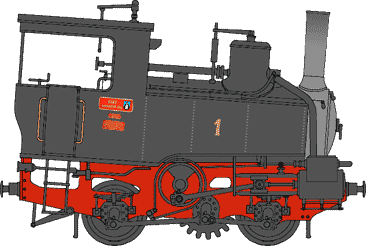Achenseebahn
Jenbach Austria
N47.388649 E11.777876


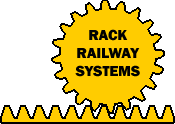 Switzerland is full of metre gauge rack railways but I'm not so sure Austria has as many. Nevertheless the steam powered Achenseebahn is both an adhesion and a rack railway (zahnradbahn) as it climbs from Jenbach up to Achen Lake (Achensee) a distance of 6.78 kilometres (4.21 miles) on a maximum grade of 16 percent. The line rises 440 metres (1,444 feet) in elevation from Jenbach utilizing the Riggenbach rack system. The rack is installed between Jenbach and Eben where there is an adhesion siding. "Up" trains stop at Eben where the locomotive runs-around the coaches then pulls them to Achensee. Another locomotive run-around is performed at Achensee where a flying switch (banned on most railways) puts the locomotive in the leading position for departure and the "down" journey from Eben to Jenbach.
Switzerland is full of metre gauge rack railways but I'm not so sure Austria has as many. Nevertheless the steam powered Achenseebahn is both an adhesion and a rack railway (zahnradbahn) as it climbs from Jenbach up to Achen Lake (Achensee) a distance of 6.78 kilometres (4.21 miles) on a maximum grade of 16 percent. The line rises 440 metres (1,444 feet) in elevation from Jenbach utilizing the Riggenbach rack system. The rack is installed between Jenbach and Eben where there is an adhesion siding. "Up" trains stop at Eben where the locomotive runs-around the coaches then pulls them to Achensee. Another locomotive run-around is performed at Achensee where a flying switch (banned on most railways) puts the locomotive in the leading position for departure and the "down" journey from Eben to Jenbach.
 On 1 Aug 1888 Emperor Franz Josef of the Austro-Hungarian Empire gave his consent to construct a railway from Jenbach to Achensee. Construction was carried out by the Soenderop Company of Berlin which completed the line for the official opening on 8 Jun 1889. Achenseebahn track ended at a station short of the steamboat pier. A 600 millimetre tram line connecting the two was used to move luggage at an extra charge. In 1916 the Austrian military administration re-laid the tram line to metre gauge. A new station serving the steamboats was constructed at the pier. Oddly, Achenseebahn locomotives were not permitted to use this section of track until they acquired it in 1929.
On 1 Aug 1888 Emperor Franz Josef of the Austro-Hungarian Empire gave his consent to construct a railway from Jenbach to Achensee. Construction was carried out by the Soenderop Company of Berlin which completed the line for the official opening on 8 Jun 1889. Achenseebahn track ended at a station short of the steamboat pier. A 600 millimetre tram line connecting the two was used to move luggage at an extra charge. In 1916 the Austrian military administration re-laid the tram line to metre gauge. A new station serving the steamboats was constructed at the pier. Oddly, Achenseebahn locomotives were not permitted to use this section of track until they acquired it in 1929.
During World War II the railway carried its largest number of passengers. Following the end of hostilities, goods and materials, in particular wood from the forests around Lake Achen, were carried by the line until this ended in 1973.
In 1950 the Tirolean Water Company purchased the majority of shares in the railway company which in turn passed the shares to the villages of Achenkirch, Maurach, and Eben in 1979. With the support of the Tirolean Water Company, State, and Federal governments, the railway was rehabilitated. The municipalities of Eben, Jenbach, and Achenkirch have been the main shareholders since 1991.
16 May 2008 was a bad date for the railway as their engine shed at Jenbach caught fire. Locomotive number 1 was severely damaged along with the shed. By the opening season of 2009 both the shed and locomotive had been rebuilt.
 Numbers: 1 to 4
Numbers: 1 to 4Wheel arrangement: 0-4-0T
Gauge: 1 m (39.37 in.)
Builder: Floridsdorf Lokomotivfabrik
Built: 1889
Fuel: Coal
Boiler pressure: 11 bar (159.5 psi)
Cylinder dia: 330 mm (12.99 in.)
Piston stroke: 500 mm (19.68 in.)
Drive wheel dia: 898 mm (35.35 in.)
Maximum speed: ? kph (? mph)
At the opening of the Achenseebahn in 1889 four cog wheel locomotives were procured. They were given the numbers 1 to 4 and the names Theodor, Hermann, Georg, and Carl. Locomotive number 4 was used for spare parts in the years after World War II and was inoperable as a result. Until 2005, the company operated exclusively with the remaining three engines, which are the oldest cogwheel locomotives in Austria. In 2005 locomotive number 4, now partially rebuilt from some old and spare parts, was steamed for the first time. However, there were still some important pieces missing so the engine was not operational for public service. Following the fire on 16 May 2008 which damaged locomotive number 1, parts were robbed and installed on engine 4 within 3 months making it operational. By the end of 2009 engine 1 was rebuilt and serviceable once again.
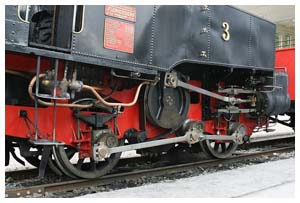 Examine these two photos below closely and you'll gain an insight into how this cog wheel steam locomotive functions on both adhesion and rack sections of track:
Examine these two photos below closely and you'll gain an insight into how this cog wheel steam locomotive functions on both adhesion and rack sections of track:
Steam pressure entering the cylinders drives the piston back and forth. The piston rod is attached to a connecting rod which drives a small wheel located centrally between the locomotive wheels. The band that encircles this small center wheel is the band brake.This small wheel is attached to the countershaft which has two small gears driving two larger gears located on each side of the pinion, or cog wheel, that's the gear that connects with the rack rail. The shaft through the pinion has eccentrics mounded on each end. Connecting rods from these eccentrics link to eccentrics on both the front and rear driving wheels. Consequently the driving wheels are powered even when the rack is not engaged on adhesion trackage.
which has two small gears driving two larger gears located on each side of the pinion, or cog wheel, that's the gear that connects with the rack rail. The shaft through the pinion has eccentrics mounded on each end. Connecting rods from these eccentrics link to eccentrics on both the front and rear driving wheels. Consequently the driving wheels are powered even when the rack is not engaged on adhesion trackage.
Achenseebahn trains have four braking methods during operation:
- Locomotive counter pressure brake - Compression of air and steam in the cylinders serves as a brake through the pinion to the rack;
- Locomotive band brake - A metal belt with wooden brake pads surrounds the grooved small wheel on the countershaft. By tightening this belt manually with a crank the engine is braked through the pinion to the rack;
- Locomotive front axle brake - Grooved cast iron brake blocks on the front axle of the locomotive are braked with a manual crank;
- Carriage brakes - The cars also have cog wheels with crank-operated brake blocks. However, these brakes are not designed to brake the entire train.
The locomotive driving wheels, although braked by counter pressure and the band brake through the gearing and connecting rods, do not contribute to the braking effort during rack operation since they are lubricated with water to reduce friction. This is necessary because their diameter differs from the cog wheel so therefore they must be able to slide slightly on the rails when braking on a rack section.
The Achenseebahn 2017 timetable is available here.
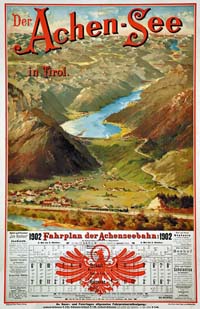
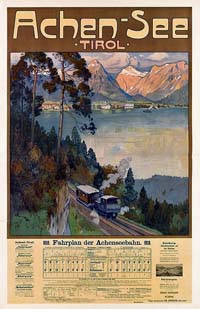
19 May 2010 - Full Steam into the Future
31 Aug 2010 - Achenseebahn Will Reach Last Year's Result
14 Oct 2010 - Photoshoot of the Jenbach Bundesmusikkapelle
28 May 2011 - Achenseebahn and Ship Cruises
28 May 2014 - Hard Cheese
6 June 2014 - Achenseebahn 125 Year Anniversary
15 Aug 2016 - Steaming Through the Holidays
5 Apr 2017 - No More Public Funding
Achenseebahn Photos
Railfan Europe Picture Gallery
Schmalspurbahnen in Österreich
Achenseer Museumswelt (Link fails 4 Jul 2024)
Regner Live Steam Locomotive Kit
Sound auf der Achenseebahn (Link fails 16 Mar 2022)
 Achenseebahn - ÖBB - ZillertalbahnGünter Denoth.2011Sutton Verlag.Paperback128 pages, 150 b&w photos, 50 photos in color, €19.45Language German. In addition to the many historical black & white photos there are beautiful color photographs of good print quality. Special thanks go to the author Günter Denoth who has assembled this extensive material.
Achenseebahn - ÖBB - ZillertalbahnGünter Denoth.2011Sutton Verlag.Paperback128 pages, 150 b&w photos, 50 photos in color, €19.45Language German. In addition to the many historical black & white photos there are beautiful color photographs of good print quality. Special thanks go to the author Günter Denoth who has assembled this extensive material. AchenseebahnKurt Plesche.1989Linda Tinker.Hardcover312 pages, used £35.00Language German. Numerous photographs, drawings, and diagrams. Chronicle of an exceptional mountain railway compiled from original documents.
AchenseebahnKurt Plesche.1989Linda Tinker.Hardcover312 pages, used £35.00Language German. Numerous photographs, drawings, and diagrams. Chronicle of an exceptional mountain railway compiled from original documents.





